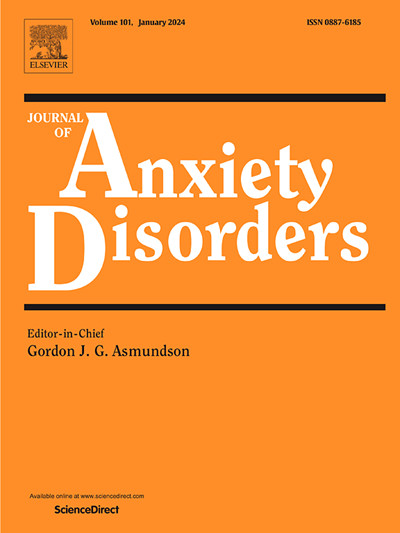性侵女性幸存者PTSD症状与日常生活疼痛的双向关联
IF 4.5
2区 医学
Q1 PSYCHIATRY
引用次数: 0
摘要
疼痛和创伤后应激障碍(PTSD)的共同发生通常用相互维持模型来解释,该模型认为每一种情况都会加剧另一种情况。我们通过使用为期三周的生态瞬时评估(EMA)设计来检查疼痛和创伤后应激障碍之间在一天内的关联来测试该模型。年轻的顺性别女性(N = 82)经历过性侵犯并报告PTSD症状和可能的酒精滥用,每天完成三次自我报告调查,评估瞬时疼痛强度和PTSD症状。动态结构方程模型的结果支持这样的假设:疼痛预示着四小时后更严重的PTSD症状,而PTSD症状预示着更大的疼痛。然而,探索性随访分析揭示了不同聚类的差异发现,例如侵入、认知和情绪的负面改变以及过度觉醒都能预测随后的疼痛,而疼痛只能预测随后的过度觉醒。研究结果增加了我们对相互维持模型的理解的细微差别,并指出,在经历过性侵犯的女性中,过度觉醒症状是将日常疼痛和创伤后应激障碍联系起来的关键症状群。研究结果强调了在综合干预中针对高觉醒症状的潜在价值。本文章由计算机程序翻译,如有差异,请以英文原文为准。
Bidirectional associations between PTSD symptoms and pain in daily life among women survivors of sexual assault
The co-occurrence between pain and posttraumatic stress disorder (PTSD) is commonly explained by the mutual maintenance model, which proposes that each condition exacerbates the other. We tested this model by examining within-day associations between pain and PTSD using a three-week ecological momentary assessment (EMA) design. Young adult cisgender women (N = 82) who experienced sexual assault and reported PTSD symptoms and probable alcohol misuse completed three self-report surveys per day assessing momentary pain intensity and PTSD symptoms. Results from a dynamic structural equation model supported hypotheses, such that pain predicted greater PTSD symptoms four hours later and PTSD symptoms predicted greater pain. However, exploratory follow up analyses revealed differential findings by cluster, such that intrusions, negative alterations in cognition and mood, and hyperarousal each predicted subsequent pain, whereas pain predicted only later hyperarousal. Findings add nuance to our understanding of the mutual maintenance model and point to hyperarousal symptoms as a key symptom cluster linking daily pain and PTSD among women who have experienced sexual assault. Findings underscore the potential value of targeting hyperarousal symptoms in integrative interventions.
求助全文
通过发布文献求助,成功后即可免费获取论文全文。
去求助
来源期刊

Journal of Anxiety Disorders
Multiple-
CiteScore
16.60
自引率
2.90%
发文量
95
期刊介绍:
The Journal of Anxiety Disorders is an interdisciplinary journal that publishes research papers on all aspects of anxiety disorders for individuals of all age groups, including children, adolescents, adults, and the elderly. Manuscripts that focus on disorders previously classified as anxiety disorders such as obsessive-compulsive disorder and posttraumatic stress disorder, as well as the new category of illness anxiety disorder, are also within the scope of the journal. The research areas of focus include traditional, behavioral, cognitive, and biological assessment; diagnosis and classification; psychosocial and psychopharmacological treatment; genetics; epidemiology; and prevention. The journal welcomes theoretical and review articles that significantly contribute to current knowledge in the field. It is abstracted and indexed in various databases such as Elsevier, BIOBASE, PubMed/Medline, PsycINFO, BIOSIS Citation Index, BRS Data, Current Contents - Social & Behavioral Sciences, Pascal Francis, Scopus, and Google Scholar.
 求助内容:
求助内容: 应助结果提醒方式:
应助结果提醒方式:


